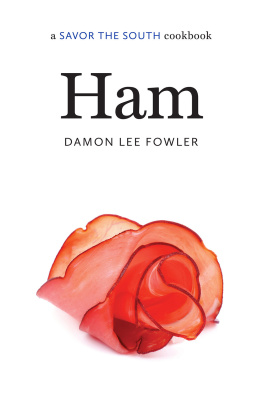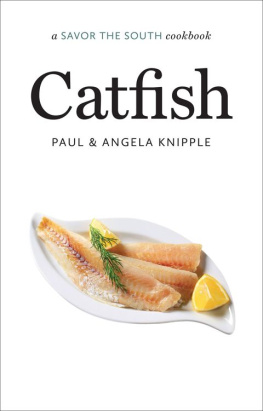Damon Lee Fowler - Ham: A Savor the South Cookbook
Here you can read online Damon Lee Fowler - Ham: A Savor the South Cookbook full text of the book (entire story) in english for free. Download pdf and epub, get meaning, cover and reviews about this ebook. year: 2017, publisher: The University of North Carolina Press, genre: Home and family. Description of the work, (preface) as well as reviews are available. Best literature library LitArk.com created for fans of good reading and offers a wide selection of genres:
Romance novel
Science fiction
Adventure
Detective
Science
History
Home and family
Prose
Art
Politics
Computer
Non-fiction
Religion
Business
Children
Humor
Choose a favorite category and find really read worthwhile books. Enjoy immersion in the world of imagination, feel the emotions of the characters or learn something new for yourself, make an fascinating discovery.
- Book:Ham: A Savor the South Cookbook
- Author:
- Publisher:The University of North Carolina Press
- Genre:
- Year:2017
- Rating:4 / 5
- Favourites:Add to favourites
- Your mark:
- 80
- 1
- 2
- 3
- 4
- 5
Ham: A Savor the South Cookbook: summary, description and annotation
We offer to read an annotation, description, summary or preface (depends on what the author of the book "Ham: A Savor the South Cookbook" wrote himself). If you haven't found the necessary information about the book — write in the comments, we will try to find it.
Ham: A Savor the South Cookbook — read online for free the complete book (whole text) full work
Below is the text of the book, divided by pages. System saving the place of the last page read, allows you to conveniently read the book "Ham: A Savor the South Cookbook" online for free, without having to search again every time where you left off. Put a bookmark, and you can go to the page where you finished reading at any time.
Font size:
Interval:
Bookmark:


a SAVOR THE SOUTH cookbook
Ham
SAVOR THE SOUTHcookbooks
Ham, by Damon Lee Fowler (2017)
Corn, by Tema Flanagan (2017)
Fruit, by Nancie McDermott (2017)
Chicken, by Cynthia Graubart (2016)
Bacon, by Fred Thompson (2016)
Greens, by Thomas Head (2016)
Barbecue, by John Shelton Reed (2016)
Crabs and Oysters, by Bill Smith (2015)
Sunday Dinner, by Bridgette A. Lacy (2015)
Beans and Field Peas, by Sandra A. Gutierrez (2015)
Gumbo, by Dale Curry (2015)
Shrimp, by Jay Pierce (2015)
Catfish, by Paul and Angela Knipple (2015)
Sweet Potatoes, by April McGreger (2014)
Southern Holidays, by Debbie Moose (2014)
Okra, by Virginia Willis (2014)
Pickles and Preserves, by Andrea Weigl (2014)
Bourbon, by Kathleen Purvis (2013)
Biscuits, by Belinda Ellis (2013)
Tomatoes, by Miriam Rubin (2013)
Peaches, by Kelly Alexander (2013)
Pecans, by Kathleen Purvis (2012)
Buttermilk, by Debbie Moose (2012)

DAMON LEE FOWLER
The University of North Carolina Press CHAPEL HILL
2017 The University of North Carolina Press
All rights reserved. Manufactured in the United States of America.
SAVOR THE SOUTH is a registered trademark of the University of North Carolina Press, Inc.
Designed by Kimberly Bryant and set in Miller and Calluna Sans types by Rebecca Evans.
The University of North Carolina Press has been a member of the Green Press Initiative since 2003.
Cover illustration istockphoto.com/zhekos
Library of Congress Cataloging-in-Publication Data
Names: Fowler, Damon Lee, author.
Title: Ham / Damon Lee Fowler.
Other titles: Savor the South cookbook.
Description: Chapel Hill : The University of North Carolina Press, [2017] | Series: A savor the South cookbook
Identifiers: LCCN 2017015401| ISBN 9781469635897 (cloth : alk. paper) | ISBN 9781469635903 (ebook)
Subjects: LCSH : Cooking (Ham) | Cooking, AmericanSouthern style. | LCGFT : Cookbooks.
Classification: LCC TX 749.5. H 35 F 69 2017 | DDC 641.3/64dc23 LC record available at https://lccn.loc.gov/2017015401
For Sam and Donna Edwards and the
folks at Edwards Virginia Smokehouse in Surry,
Virginia, in honor of their commitment to
fine southern-cured hams
And, as always, for Timothy
SOUTHERNERS AND HAM: A LOVE STORY
The wag who first defined eternity as two people and a ham is lost to time: Though often credited to mid-twentieth-century wit Dorothy Parker, theres actually no record of when or if she ever said it. But theres one thing you can bet on: whoever did say it wasnt a southerner.
While the hindquarters of swine have been preserved in salt the world over for thousands of years, there is probably no other place on earth, except possibly Italy and Spain, where ham is as celebrated or integral to the cuisine as it is in the American South.
To begin to understand the place that this iconic food holds in the hearts of the South and its food history, one has only to step into the two-hundred-year-old smokehouse in the South dependency of Thomas Jeffersons beloved Monticello and take a deep breath. More than a century after the last hams were hung to smoke in that chamber, the aroma of salt, smoke, and air-dried pork still permeates the rough masonry walls and red clay floor, filling the air with its earthy perfume. Likewise, even after four centuries and the inevitable transformations that immigration and globalization have brought to the Souths many cultures and cuisines, that same earthy perfume lingers in kitchens throughout the region.
Although swine arent native to North America, theyve been an integral part of the South and its cookery from the earliest days of European colonization. Pigs are believed to have been introduced to the region in Florida and coastal Georgia by Spanish colonials in the late sixteenth century. But even before the animals themselves set foot on American soil, their dry-salted and/or pickled (brine-cured) flesh was surely part of the provisions those settlers brought with them, as it would have been a few years later for the first permanent English settlers at Jamestown, Virginia. In those shaky early days, the colonists depended largely on imported provisions, but soon they were raising, slaughtering, and preserving their own pigs.
The advantage of swine for these colonial outposts was that they didnt need a lot of attention to thrive. Pigs will eat just about anything and everything, and can pretty much be left to fend for themselves. Often they were simply turned loose (or got loose) to forage in the forests, and a lot of them stayed there. The wild boars that now populate the Souths woodlands (and which, thanks in part to the urbanization of their habitats, have today become such a menace) are all descended from those early domestic animals that just never came back home.
The one disadvantage of pork, particularly in those days before cold storage, is that its far more perishable than any other meat and back then had to be eaten pretty much as soon as it was slaughtered. This was why hog-killing time occurred in autumn with the first cold snap. But that little defect disappeared as soon as the meat was exposed to salt. Once its properly cured and stored, itll keep for months, even years, without refrigeration. In a largely rural economy, where most families were farmers raising their own food and cold storage consisted of a spring house and root cellar, having fresh meat every single day wouldve meant slaughtering an animal almost every day, something that would have been impractical even if it was possible. Cured pork therefore became a critical source of animal protein and a staple in every diet, whether the household was rich or poor, at liberty or enslaved.
Edmund Bacon, Thomas Jeffersons estate overseer from 1806 to 1822, wrote that his master often told him that the weekly ration of salt pork for each of his enslaved workers was more than he could have consumed in six months. That remark is usually quoted as evidence of Jeffersons simple and largely vegetarian diet, but in the bigger picture it also tells us that salt pork was the fuel that kept Monticello, and indeed, every other plantation and farm in the South, going.
And while Jefferson may not have partaken of it very often, one of the well-aged hams from that aromatic smokehouse, boiled and toasted (that is, carefully poached in water to cover and then coated with crumbs and browned in the oven) would have been a fixture on Monticellos table. Martha Washington, whose social and political position required her to entertain a steady stream of visitors at Mount Vernon, was reputed to have ordered a ham from the kitchen almost every single day. And scarcely half a century later, Annabella Hill, author of Mrs. Hills New Cook Book (1867) and one of the nineteenth centurys great chroniclers of southern cookery, referred to boiled ham as our favorite every-day dish.
The proper curing and storing of pork, particularly of hams, was therefore a critical skill. Not surprisingly, the most ubiquitous, lengthy, and detailed recipes, both in published southern cookbooks beginning with Mary Randolphs
Font size:
Interval:
Bookmark:
Similar books «Ham: A Savor the South Cookbook»
Look at similar books to Ham: A Savor the South Cookbook. We have selected literature similar in name and meaning in the hope of providing readers with more options to find new, interesting, not yet read works.
Discussion, reviews of the book Ham: A Savor the South Cookbook and just readers' own opinions. Leave your comments, write what you think about the work, its meaning or the main characters. Specify what exactly you liked and what you didn't like, and why you think so.




